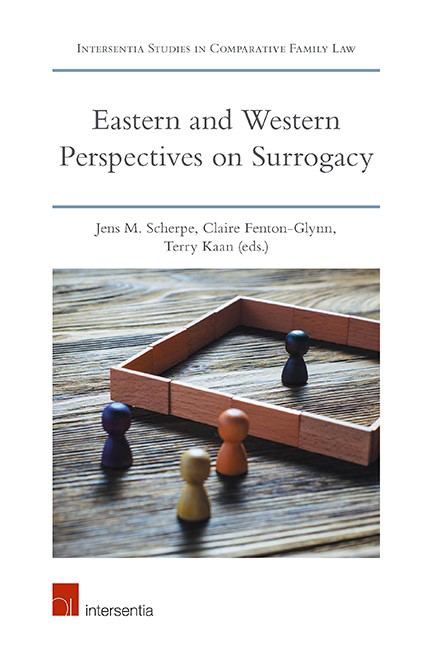Book contents
- Frontmatter
- Preface and Acknowledgements
- Contents
- List of Contributors
- Introduction
- Questionnaire
- PART I WESTERN PERSPECTIVES
- THE PROHIBITIVE APPROACH
- THE TOLERANT APPROACH
- THE REGULATORY APPROACH
- THE FREE MARKET APPROACH
- THE INFLUENCE OF INTERNATIONAL COURTS
- PART II EASTERN PERSPECTIVES
- THE PROHIBITIVE APPROACH
- A TOLERANT APPROACH?
- REGULATION THROUGH PROFESSIONAL MEDICAL BODIES
- FROM FREE MARKET TO REGULATION
- India
- Thailand
- PART III COMPARATIVE PERSPECTIVES ON SURROGACY
- Index
- About the Editors
India
from FROM FREE MARKET TO REGULATION
Published online by Cambridge University Press: 26 June 2019
- Frontmatter
- Preface and Acknowledgements
- Contents
- List of Contributors
- Introduction
- Questionnaire
- PART I WESTERN PERSPECTIVES
- THE PROHIBITIVE APPROACH
- THE TOLERANT APPROACH
- THE REGULATORY APPROACH
- THE FREE MARKET APPROACH
- THE INFLUENCE OF INTERNATIONAL COURTS
- PART II EASTERN PERSPECTIVES
- THE PROHIBITIVE APPROACH
- A TOLERANT APPROACH?
- REGULATION THROUGH PROFESSIONAL MEDICAL BODIES
- FROM FREE MARKET TO REGULATION
- India
- Thailand
- PART III COMPARATIVE PERSPECTIVES ON SURROGACY
- Index
- About the Editors
Summary
GENERAL LEGAL FRAMEWORK
THE LEGAL FRAMEWORK FOR SURROGACY
There is no specific statute at the federal level or provincial state level on surrogacy in India as of February 2019. The Surrogacy (Regulation) Bill 2016 (hereafter ‘SRB’) has been approved by the Union Cabinet of Ministers at the federal government and was introduced in Parliament in late 2016. It was referred to a Parliamentary Standing Committee in January 2017, which submitted its report in August 2017. The revised Bill, the Surrogacy (Regulation) Bill 2018 based on the SRB, was passed by the lower house of Parliament in December 2018 but is yet to be considered by the upper house. The SRB has been quite controversial; details of the SRB will be discussed later in this chapter in Sections 2–6.
In the absence of any statutory framework, two sets of guidelines and rules currently apply to surrogacy in India. The first are the National Guidelines for Accreditation, Supervision and Regulation of ART Clinics in India, published by the Ministry of Health and Family Welfare and drafted by the Indian Council of Medical Research (‘ICMR’) in 2005 (hereafter ‘ICMR Guidelines’). These guidelines are not considered to be binding but several Indian fertility clinics, particularly the well-known clinics claim to abide by them.
Apart from the ICMR guidelines there are executive orders issued by various Indian federal ministries. In 2012, the Ministry of External Affairs issued a circular to regulate the use by foreign couples of surrogacy services in India, including the need to obtain a surrogacy visa prior to commencing their treatment using assisted reproduction techniques (hereafter ‘ART’) and an exit visa after the surrogacy transaction was concluded. In 2015 however, this 2012 circular was superseded by an order of the Ministry of External Affairs and Health – which banned surrogacy by foreigners and details of which are set out later in this section. Since 2015, therefore, only foreign couples who had commenced their ART treatment prior to the ban have continued to use the services of fertility clinics and Indian surrogates. Commercial surrogacy however continues to be undertaken by commissioning parents who are Indian citizens although in far fewer numbers when compared to foreign commissioning parents.
- Type
- Chapter
- Information
- Eastern and Western Perspectives on Surrogacy , pp. 469 - 498Publisher: IntersentiaPrint publication year: 2019
- 2
- Cited by

